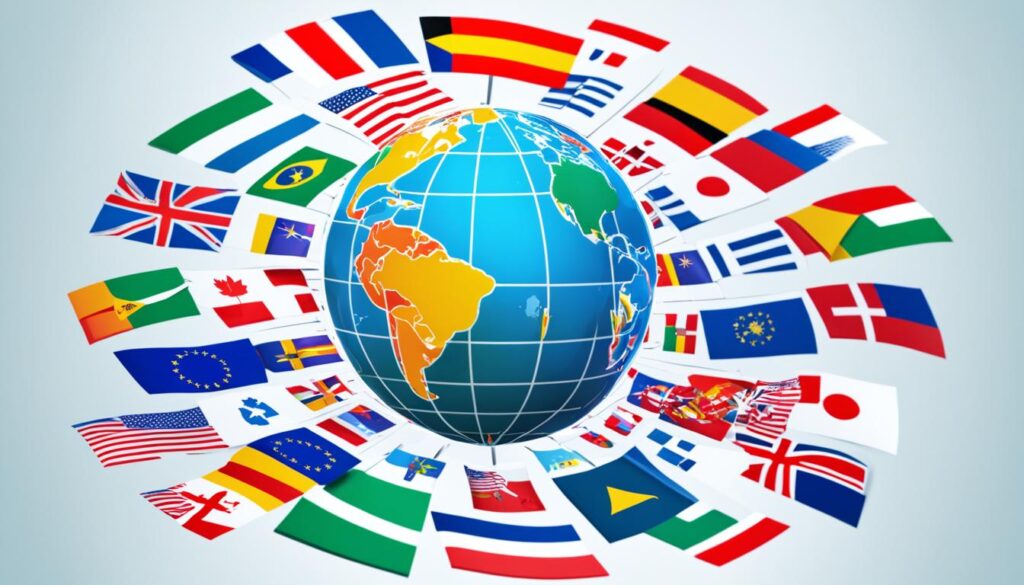
When it comes to expanding your global reach and engagement, implementing a Multilingual SEO Strategy is key. By optimizing your website content, keywords, and metadata in multiple languages, you can effectively attract target audiences in different language markets. This allows you to tap into new opportunities and increase your visibility in various regions, ultimately driving more traffic and revenue.
With a well-executed Multilingual SEO Strategy, you can improve your search engine rankings and attract local customers who are more likely to convert. By targeting language-specific keywords and providing localized content, you enhance the user experience and build trust with international audiences. Additionally, optimizing your website in different languages increases your chances of being found in search results across different language versions of search engines.
Key Takeaways:
- A Multilingual SEO Strategy is essential for businesses looking to expand their global reach and engage with audiences in different language markets.
- Implementing a well-executed Multilingual SEO Strategy can lead to higher search engine rankings, increased website traffic, and more conversions.
- Localization of content and targeting language-specific keywords are crucial for attracting and retaining local customers.
- Thorough keyword research and high-quality translation are key best practices in developing a Multilingual SEO Strategy.
- Implementing hreflang tags correctly helps search engines understand the language and regional targeting of each version of your website.
The Benefits of Multilingual SEO
Implementing a multilingual SEO strategy offers several benefits for businesses aiming to expand their global reach and increase international sales. By optimizing website content for different languages, businesses can tap into new international markets and effectively target local customers.
One of the key advantages of multilingual SEO is the ability to optimize for language-specific keywords. By understanding the search behavior and preferences of users in different regions, businesses can tailor their content and keywords to attract localized traffic. This targeted approach increases the likelihood of reaching customers who are more likely to convert, ultimately leading to improved sales and revenue.
Localized Content for Enhanced User Experience
In addition to targeting language-specific keywords, implementing a multilingual SEO strategy allows businesses to provide localized content in different languages. This not only enhances the user experience by offering content in their preferred language, but it also builds trust and credibility with international audiences.
Localized content shows that the business values and understands the needs of customers in different regions, establishing a stronger connection. By providing information, products, and services in the local language, businesses can overcome language barriers and create a more inclusive and personalized experience for their international customers.
Improved Search Engine Rankings and Visibility
One of the primary goals of SEO is to improve search engine rankings and increase visibility. Multilingual SEO takes this a step further by optimizing websites for different language versions of search engines. When businesses implement multilingual SEO strategies, search engines understand the relevance of the content for specific languages and regions, increasing the chances of being found by potential customers.
By targeting specific language markets and optimizing content accordingly, businesses can achieve higher rankings in search engine results for each language version. This increased visibility greatly boosts the chances of attracting organic traffic and capturing the attention of potential customers in different regions.
Overall, the benefits of multilingual SEO are clear. By tapping into new international markets, optimizing for language-specific keywords, providing localized content, and improving search engine rankings and visibility, businesses can maximize their global reach, engage with a wider audience, and drive international sales.

Best Practices for Multilingual SEO
Creating an effective multilingual SEO strategy requires following best practices to ensure optimal results. The first step is conducting thorough keyword research in each target language. This process involves identifying the most relevant and high-volume keywords, taking into account language nuances, cultural differences, and search behavior in each market. By understanding the specific keywords that resonate with the target audience, businesses can enhance their visibility and attract more organic traffic.
Once the keywords are identified, the next crucial step is to focus on translation quality and localization of website content. High-quality translation and localization play a vital role in ensuring accurate and natural-sounding copy for each language. Poor translations not only harm the user experience but also negatively impact search engine rankings. By investing in professional translation services, businesses can effectively communicate their brand's message and engage with international audiences.
Another important aspect of multilingual SEO is implementing hreflang tags correctly. Hreflang tags allow search engines to understand the specific language and regional targeting of each version of the website. By indicating the language and location preferences, businesses can ensure that search engines display the appropriate version of the website to users. This helps in providing a personalized and relevant experience to visitors from different regions, increasing their likelihood of conversion.
In conclusion, incorporating best practices such as comprehensive keyword research, high-quality translation, and accurate implementation of hreflang tags are essential for a successful multilingual SEO strategy. These practices not only improve search engine rankings but also enhance the overall user experience, leading to increased visibility, engagement, and conversions in different language markets.
FAQ
What is a multilingual SEO strategy?
A multilingual SEO strategy involves optimizing website content, keywords, and metadata in multiple languages to improve visibility and attract target audiences in different regions.
Why is building a multilingual SEO strategy important?
Building a multilingual SEO strategy is essential for businesses looking to maximize their global reach and engagement across various language markets. It can lead to higher rankings in search engine results, increased website traffic, and ultimately, more conversions and revenue.
What are the benefits of implementing a multilingual SEO strategy?
Implementing a multilingual SEO strategy offers several benefits. First, it allows businesses to tap into new international markets and expand their customer base. Additionally, it enhances the user experience and builds trust with international audiences. Finally, it improves search engine rankings and visibility in different language versions of search engines, increasing the chances of being found by potential customers.
What are the best practices for multilingual SEO?
To create an effective multilingual SEO strategy, there are several best practices to follow. These include conducting thorough keyword research in each target language, ensuring high-quality translation and localization of website content, and implementing hreflang tags correctly to indicate language and regional targeting to search engines.











